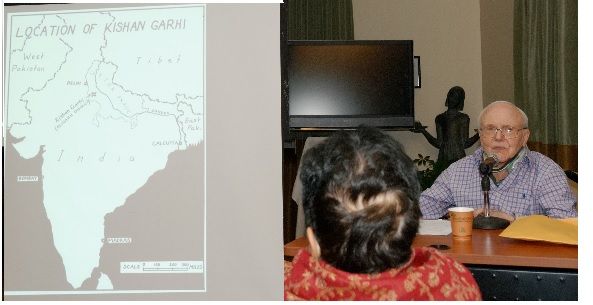Sunthar Visuvalingam
Chicago: McKim Marriott, professor emeritus of anthropology at the University of Chicago (UC), who will be 95 this April, gave a well-attended PowerPoint presentation at Montgomery Place Retirement Home on his fieldwork dating back to 1951-52 on the spring festival of Holi.
His pioneering observations, analyses and (philosophical) reflections as a willing participant in the collective life of ‘Kishan Garhi’, a village located 100 miles southeast of Delhi, were published as an essay titled “The Feast of Love” (1966) that has since become a veritable classic in our understanding of traditional Indian society.
Marriott describes in careful detail the social ranking of the 20 different Hindu and four Muslim castes as revealed in day-to-day interactions and collective festivals, microcosm of a world where, despite inevitable tensions and conflicts, everyone knows their proper place in the dharmic order. During Holi, however, he is shocked and perplexed to see all these rules deliberately violated, with the high and the low, the near and the distant, coming together to mutually embrace around the all-consuming bonfire. The anthropologist himself is sucked into this ‘festival of love’ to be paraded as an ignorant clown.
The essay’s universal significance is underlined by recent scholarly and wider cultural developments. A French translation supplemented by a long critical review appeared in November 2017 in a cross-cultural revue devoted to comparative study of this topsy-turvy world of the carnival. Its two co-authors, an Indologist and a sociologist, juxtapose Marriott to his famous French counterpart Louis Dumont who, influenced by the former, studied and interpreted Hindu society entirely in terms of (caste) hierarchy.
Kim, as Marriot is fondly addressed, arrived in Delhi in 1945, when the colonial administration was wary of American researchers, suspected of sympathies for the freedom struggle. He was admitted because of his intelligence assignment decoding Japanese communications especially in the China theater. Exposure to Indian life, behavior and alien ways of thinking, raised so many unanswered questions that, upon returning, he studied South Asian anthropology at UC, where he became a leading theorist.
Indology thrives on the systematic application of evolving, mutually conflicting, paradigms derived from Western disciplines such as sociology, psychology, history, etc., to traditional modes of life, with typically prejudicial results vis-à-vis their object of study. When an approach proves unsatisfactory, the scholar often resorts to multiple interpretative frameworks of disparate origin, rather than admit their fundamental inadequacy.
This domineering tendency finds its crowning expression in Wendy Doniger’s notorious ‘monkey-and-toolbox’ method of (mis-) using all conceptual tools at hand, as if Hinduism could not be understood in terms of its own native categories. Unlike his junior UC colleague, Kim drew the diametrically opposed conclusion that these ‘disciplines’ were (mere) ‘ethno-sciences’ that, however relevant to modern Western societies, are counterproductive for understanding alien civilizations, such as those of India, Islam, China and Japan. In this deeper sense, Kim has never been an Indologist’.
Throughout his fieldwork, Kim was struck by the constant and consistent resort of Hindu villagers to earth-water-fire-air-ether and sattva-rajas-tamas as categories of thought for understanding their world. Though these ‘five elements’ and ‘three qualities (guna)’ have been well studied as integral to the ancient Sankhya ‘philosophy’ (darshana), they have never been taken seriously enough, even by Indian scholars, as viable tools for deciphering the Hindu cosmos that has survived in traditional rural life. Despite having retired decades ago and fighting against repeated obstacles posed by age, Kim persists in developing a mathematical model of these categories that will be intelligible to the modern mind.
Kim’s extensive archives of photos, diagrams, interviews, notes, etc., from his fieldwork, especially at the historic cultural center of Wai in Maharashtra, are finally being filed and catalogued at UC library to provide fodder for future PhD students. Despite all the lip service, however, his sharp critique of Indology as ‘ethno-science’, especially as cultivated here at UC, has yet to be taken up in earnest within the academy.
It has instead been explicitly embraced by Hindu public intellectual Rajiv Malhotra, as exemplified by his book Being Different: An Indian Challenge to Western Universalism (2011), which has an entire well-received chapter on “Order and Chaos” inspired by (social) phenomena such as Holi. Rajiv visited Kim in November 2012 and had been sending him his publications: whatever reservations Kim may have regarding specific stances, he has expressed sympathy for Rajiv’s project of reversing the gaze.
Dedicated to Kim, my recent publication on “Carnival and Transgression in India: Towards a Global Spring?” (January 2018) analyzes the transplantation and growth of Holi in North America within and beyond the Hindu Diaspora. More than that, it aims to understand the ‘color revolutions’ that have swept across Central Asia, North Africa, Middle East and now from Eastern into Western Europe, as exemplified by the ongoing Yellow Vest movement in France, through such carnivalesque reversal.







